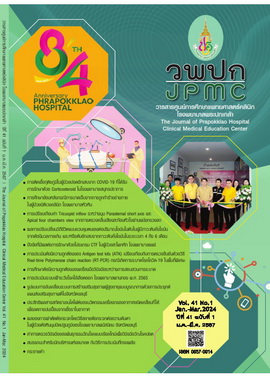Results of Self-controlled Lifestyle Modification on Fatty Liver in Individual Outrange BMI and/or Hepatitis from Steatosis from 4 to 6 months
Main Article Content
Abstract
BACKGROUND: Nowadays, overwhelming food habits and inactivity have caused fatty accumulation in urban populations, which necessitate lifestyle modification and exercise for improvement.
OBJECTIVE: This study aimed to compare changes in the Controlled Attenuation Parameter (CAP score) between a self-controlled lifestyle modification group and a traditional care group.
METHODS: Therapeutic research was conducted with a retrospective and prospective observational interrupted time design to screen participants who had fatty accumulation. The control group (between March 2020 and August 2023) received traditional care, while the study group (between September 2022 and March 2023) was asked to adopt a self-controlled lifestyle that included a diabetic diet and economically light exercise for 150 minutes per week with one follow-up. At the beginning and end of the follow-up period (4-6 months), data on each patient were obtained. Multivariable median difference regression was used to compare the CAP score changes between groups.
RESULTS: Only 39 of the 263 screened participants (16 controls and 23 study participants) were enrolled in the study. Most were women with the same age. Liver enzymes were higher in the study group. After correcting for inequitable factors between groups, the changes in the study group for CAP score were more reduced than those in the control group, decreasing by -24.98 dB/m (95%CI: -75.29, 25.34, p=0.32), notably in the group with decreasing body weight.
CONCLUSIONS: Self-control with a diabetic diet and exercises tended to reduce fat accumulation in the liver. Social and medical support should enhance people health.
Article Details

This work is licensed under a Creative Commons Attribution-NonCommercial-NoDerivatives 4.0 International License.
References
World Health Organization. Obesity and overweight [Internet]. 2021 [cited 2023 Sep 24]. Available from: https://www.who.int/news-room/fact-sheets/detail/obesity-and-overweight
Aekplakorn W, Puckcharern H, Satheannoppakao W. Health Survey in Thailand 6th 2019-2020 [Internet]. 2021 [cited 2023 Sep 24]. Available from: https://www.hsri.or.th/research/detail/13462
Bae JC, Kim SK, Han JM, Kwon S, Lee DY, Kim J, et al. Additive effect of non-alcoholic fatty liver disease on the development of diabetes in individuals with metabolic syndrome. Diabetes Res Clin Pract 2017:129:136-43.
Shariq OA, McKenzie TJ. Obesity-related hypertension: a review of pathophysiology, management, and the role of metabolic surgery. Gland Surg 2020;9:80-93.
Vekic J, Zeljkovic A, Stefanovic A, Jelic-Ivanovic Z, Spasojevic-Kalimanovska V. Obesity and dyslipidemia. Metabolism 2019:92:71-81.
Treeprasertsuk S, Leverage S, Adams LA, Lindor KD, St Sauver J, Angulo P. The Framingham risk score and heart disease in nonalcoholic fatty liver disease. Liver Int 2012;32:945-50.
Vancells Lujan P, ViñasEsmel E, SacanellaMeseguer E. Overview of non-alcoholic fatty liver disease (NAFLD) and the role of sugary food consumption and other dietary components in its development. Nutrients [Internet] 2021 [cited 2023 Apr 25];13:1442. Available from: https://www.ncbi.nlm.nih.gov/pmc/articles/PMC8145877/pdf/nutrients-13-01442.pdf
Papatheodoridi M, Hiriart JB, Lupsor-Platon M, Bronte F, Boursier J, Elshaarawy O, et al. Refining the baveno VI elastography criteria for the definition of compensated advanced chronic liver disease. J Hepatol. 2021;74:1109-16.
Zhou YJ, Gao F, Liu WY, Wong GL, Mahadeva S, Raihan Nik Mustapha N, et al. Screening for compensated advanced chronic liver disease using refined baveno VI elastography cutoffs in Asian patients with nonalcoholic fatty liver disease. Aliment Pharmacol Ther 2021;54:470-80.
Sasso M, Sandrin L, Beaugrand M. The controlled attenuation parameter (CAP): a novel tool for the non-invasive evaluation of steatosis using fibroscan. Clin Res Hepatol Gastroenterol 2012;36:13-20.
Karlas T, Petroff D, Garnov N, Böhm S, Tenckhoff H, Wittekind C, et al. Non-invasive assessment of hepatic steatosis in patients with NAFLD using controlled attenuation parameter and 1H-MR spectroscopy. PLoS One [Internet]. 2014 [cited 2023 Apr 25].;9(3):e91987. Available from: https://www.ncbi.nlm.nih.gov/pmc/articles/PMC3956815/pdf/pone.0091987.pdf
Petta S, Wong VW, Cammà C, Hiriart JB, Wong GL, Marra F, et al. Improved noninvasive prediction of liver fibrosis by liver stiffness measurement in patients with nonalcoholic fatty liver disease accounting for controlled attenuation parameter values. Hepatology 2017;65:1145-55.
de Lédinghen V, Wong GL, Vergniol J, Chan HL, Hiriart JB, Chan AW, et al. Controlled attenuation parameter for the diagnosis of steatosis in non-alcoholic fatty liver disease. J Gastroenterol Hepatol 2016;31:848-55.
Powell EE, Cooksley WG, Hanson R, Searle J, Halliday JW, Powell LW. The natural history of nonalcoholic steatohepatitis: a follow-up study of forty-two patients for up to 21 years. Hepatology 1990;11:74-80.
Eslam M, Newsome PN, Sarin SK, Anstee QM, Targher G, Romero-Gomez M, et al. A new definition for metabolic dysfunction associated fatty liver disease: an international expert consensus statement. J Hepatol 2020;73:202-9.
Seto WK, Yuen MF. Nonalcoholic fatty liver disease in Asia: emerging perspectives. J Gastroenterol 2017;52:164-74.
Oh S, Tsujimoto T, Kim B, Uchida F, Suzuki H, Iizumi S, et al. Weight-loss-independent benefits of exercise on liver steatosis and stiffness in Japanese men with NAFLD. JHEP Rep [Internet]. 2021 [cited 2023 June 10];3(3):100253. Available from: https://www.ncbi.nlm.nih.gov/pmc/articles/PMC8059085/pdf/main.pdf
Thoma C, Day CP, Trenell MI. Lifestyle interventions for the treatment of non-alcoholic fatty liver disease in adults: a systematic review. J Hepatol 2012;56:255-66.
Koutoukidis DA, Koshiaris C, Henry JA, Noreik M, Morris E, Manoharan I, et al.The effect of the magnitude of weight loss on non-alcoholic fatty liver disease: a systematic review and meta-analysis. Metabolism [Internet]. 2021 [cited 2023 Nov 12];115:154455. Available from: https://www.metabolismjournal.com/article/S0026-0495(20)30319-X/fulltext
Park Y, Sinn DH, Kim K, Gwak GY. Associations of physical activity domains and muscle strength exercise with non-alcoholic fatty liver disease: a nation-wide cohort study. Sci Rep [Internet]. 2023 [cited 2023 Mar 15];13(1):4724. Available from: https://www.ncbi.nlm.nih.gov/pmc/articles/PMC10036618/pdf/41598_2023_Article_31686.pdf
Semmler G, Datz C, Reiberger T, Trauner M. Diet and exercise in NAFLD/NASH: Beyond the obvious. Liver Int 2021;41:2249-68.
Clamp LD, Hume DJ, Lambert EV, Kroff J. Enhanced insulin sensitivity in successful, long-term weight loss maintainers compared with matched controls with no weight loss history. Nutr Diabetes[Internet]. 2017[cited 2023 Mar 10):e282. Available from: https://www.ncbi.nlm.nih.gov/pmc/articles/PMC5519190/pdf/nutd201731a.pdf

